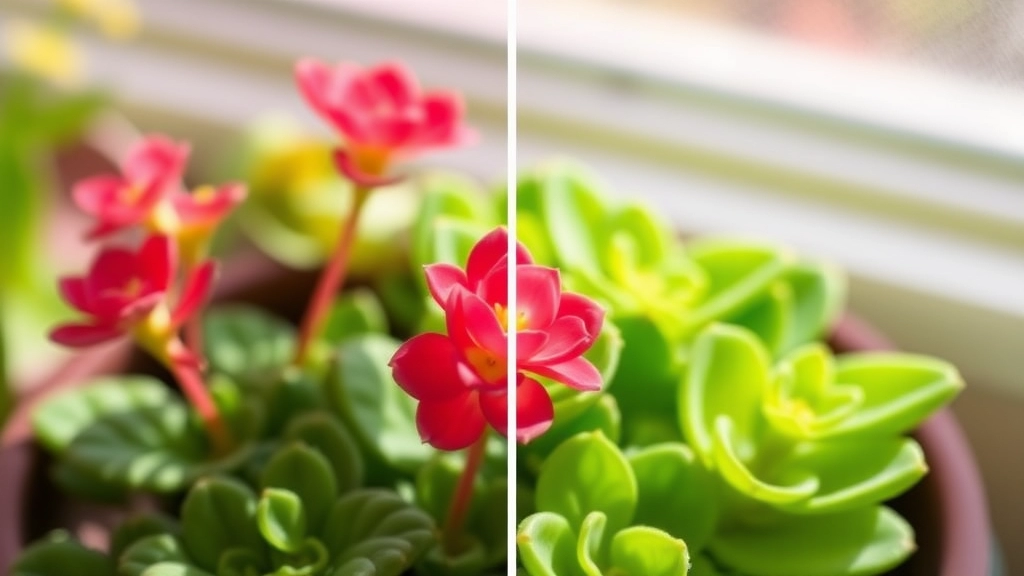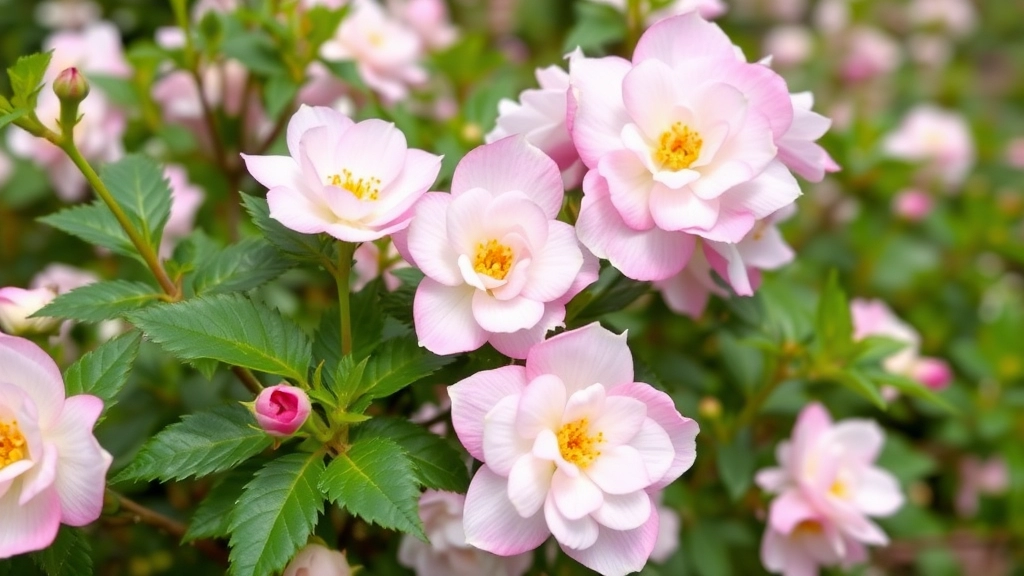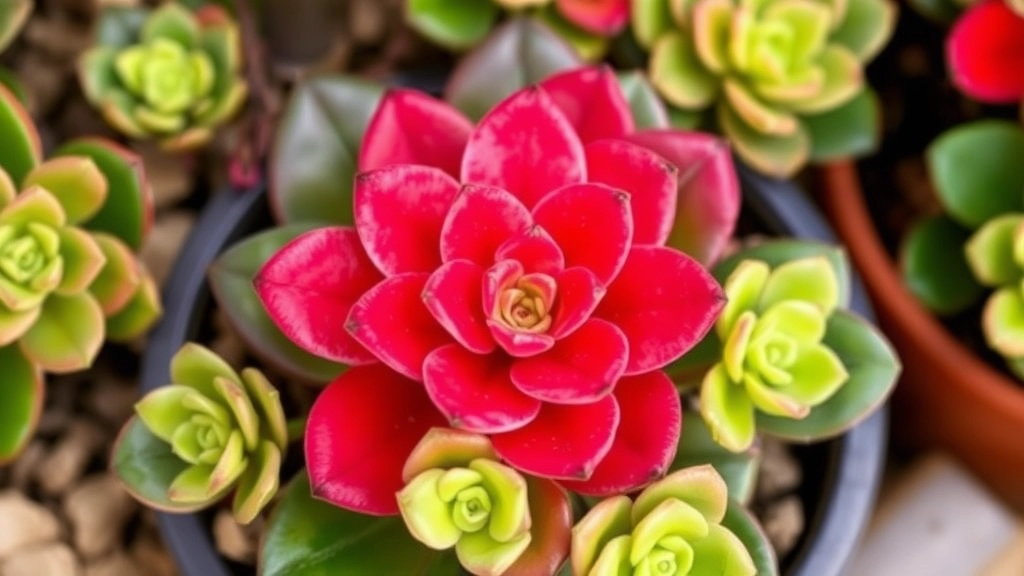Mastering Kalanchoe Care
Looking to master the art of how to care for Kalanchoe succulent? You’ve come to the right place. As a plant enthusiast, I know the joy of seeing a thriving Kalanchoe. Let’s dive into the essentials, starting with choosing the right location and understanding the light conditions these beautiful succulents need.
Key Care Tips
Next, we’ll cover watering tips to prevent overwatering, the best soil and potting mix, and how to fertilize your Kalanchoe for optimal growth. We’ll also explore pruning techniques, propagation methods, and managing common pests. By the end of this guide, you’ll have all the knowledge you need to keep your Kalanchoe healthy and blooming.
When it comes to growing a healthy Kalanchoe, one of the first questions you might ask yourself is, âWhere should I place my plant for the best results?â
Selecting the right location is crucial for your Kalanchoe’s growth and overall health.
Here are some key factors to consider:
– **Light Exposure:** Kalanchoes thrive in bright, indirect sunlight. A south-facing window is often ideal, as it provides ample light without overwhelming the plant. For more detailed care tips, you can refer to the [complete care guide for Kalanchoe Blossfeldiana](https://planthq.org/complete-care-guide-for-kalanchoe-blossfeldiana-succulent/).
– **Temperature:** These succulents prefer warmer temperatures, ideally between 18°C to 24°C. Avoid placing them near drafts or cold windows. If you’re curious about the optimal temperature conditions, check out the [ideal temperature for Kalanchoe Blossfeldiana growth](https://planthq.org/ideal-temperature-for-kalanchoe-blossfeldiana-growth/).
– **Humidity Levels:** Kalanchoes are quite adaptable, but they do best in moderate humidity. If your home is particularly dry, consider using a humidity tray or a room humidifier.
– **Space to Breathe:** Ensure that your Kalanchoe has enough space around it. Crowding can lead to poor air circulation and increase the risk of pests and diseases.
– **Accessibility for Care:** Choose a spot that makes it easy for you to water, prune, and check for pests. Keeping your plant within reach will encourage regular maintenance.
By thoughtfully considering these aspects, you can provide your Kalanchoe with a nurturing environment that promotes growth and blooming.
Ideal Light Conditions for Kalanchoe Growth

So, you’ve got your Kalanchoe, and now you’re wondering how to give it the best light to thrive? You’re not alone! Many plant lovers fret over whether their green buddy is getting enough sunshine.
Bright, Indirect Light is Key
Kalanchoe plants are native to Madagascar, which means they love bright light. But here’s the kicker: they prefer indirect sunlight. Too much direct sun can scorch those lovely leaves.
- Ideal Spot: A south or west-facing window is perfect.
- Avoid: Direct midday sun, especially in summer.
Signs Your Kalanchoe is Happy
How can you tell if your Kalanchoe is basking in the right light? Look for these signs:
- Healthy Growth: New leaves sprouting and vibrant colours.
- Stretching: If it’s reaching towards the light, it might need a brighter spot.
- Leaf Discolouration: Yellowing leaves? That could mean too much sun!
Adjusting Light Conditions
If you notice your plant isn’t thriving, don’t panic! Here’s how to adjust:
- Move it: Shift your Kalanchoe to a brighter spot or further from the window.
- Rotate: Give it a spin every now and then for even light exposure.
Seasonal Changes
As the seasons shift, so does the light. During winter, you might need to reposition your Kalanchoe to catch those precious rays.
Watering Kalanchoe: Tips to Prevent Overwatering
When it comes to caring for your Kalanchoe, one of the most common worries is watering. Overwatering can lead to root rot, a fast track to a wilting plant.
Understanding Your Kalanchoe’s Needs
Kalanchoe plants thrive in dry conditions, making them a popular choice for those who may not have a green thumb. Here are some essential tips to ensure you’re watering correctly:
- Check the Soil Moisture: Before watering, stick your finger about an inch into the soil. If it feels dry, it’s time to water. If it’s still moist, hold off.
- Water Sparingly: Kalanchoes prefer to be on the drier side. Water them once every two to three weeks, depending on the season. In winter, you can even reduce this to once a month.
- Use Well-Draining Pots: Ensure your pot has drainage holes. This allows excess water to escape, preventing water from sitting at the bottom.
- Water Thoroughly: When you do water, do so thoroughly until water drains from the bottom. This encourages deep root growth.
- Adjust for Environment: Factors like humidity and temperature can affect how often you need to water. In a dry climate, you may need to water more frequently.
Signs of Overwatering
Keep an eye out for these red flags:
- Yellowing leaves
- Soft, mushy stems
- A foul smell from the soil
If you notice these signs, it’s time to reassess your watering routine. For more detailed guidance, check out our Kalanchoe Tomentosa watering best practices and ensure you’re providing optimal care. Additionally, if you’re interested in learning about different varieties and their specific needs, visit our guide on Kalanchoe Tomentosa varieties and care tips.
Soil and Potting Mix Recommendations

When it comes to ensuring your Kalanchoe thrives, choosing the right soil is essential. Many plant enthusiasts often wonder, “What kind of soil should I use for my Kalanchoe?”
Kalanchoe plants prefer a well-draining potting mix that mimics their natural habitat. Here’s what you should consider:
- Cactus Mix: A pre-packaged cactus or succulent mix is ideal. These mixes are designed for excellent drainage, preventing the roots from sitting in water.
- DIY Potting Mix: If you prefer a homemade approach, consider mixing:
- 1 part potting soil
- 1 part perlite or coarse sand
- 1 part pine bark or orchid bark
This combination provides the right balance of moisture retention and drainage.
- pH Level: Aim for a slightly acidic to neutral pH (around 6.0 to 7.0). You can test the pH using a simple soil test kit, which is readily available.
- Container Choice: Ensure your pot has drainage holes. Terracotta pots are an excellent choice, as they allow moisture to evaporate more quickly.
Using the right soil not only promotes healthy growth but also reduces the risk of root rot, which is a common issue for Kalanchoe owners.
When it comes to keeping your Kalanchoe thriving, understanding how and when to fertilise is crucial. Many plant owners worry about over-fertilising or underfeeding, which can lead to poor growth or even damage.
### Understanding Fertiliser Needs
Kalanchoe plants are relatively low-maintenance and do not require heavy feeding. However, providing the right nutrients at the right time can significantly enhance their growth and blooming potential.
### When to Fertilize
– **Growing Season**: The best time to fertilise is during the growing season, which typically runs from spring to early autumn.
– **Frequency**: Aim to feed your Kalanchoe every 4 to 6 weeks during this period.
### Types of Fertiliser
– **Balanced Fertiliser**: A balanced, water-soluble fertiliser (such as a 10-10-10 NPK) is ideal.
– **Dilution**: Always dilute the fertiliser to half the recommended strength to avoid burning the roots.
– **Organic Options**: Consider using organic fertilisers like fish emulsion or seaweed extract for a more natural approach.
### How to Apply Fertiliser
– **Watering First**: Water your Kalanchoe a day before applying fertiliser. This helps prevent root burn.
– **Even Distribution**: Apply the fertiliser evenly around the base of the plant, avoiding direct contact with the leaves.
– **Follow Up**: After fertilising, water the plant lightly to help the nutrients soak into the soil.
### Signs Your Kalanchoe Needs Fertiliser
– **Pale Leaves**: If the leaves appear pale or yellowing, it may be time to feed.
– **Stunted Growth**: Slow or stunted growth can indicate a nutrient deficiency.
For more specific care instructions, you might want to check out the [ultimate guide to Kalanchoe blossfeldiana hybrid care](https://planthq.org/ultimate-guide-to-kalanchoe-blossfeldiana-hybrid-care/) or learn about the [best soil for Kalanchoe blossfeldiana](https://planthq.org/best-soil-for-kalanchoe-blossfeldiana-care-tips/). These resources provide detailed information that can help you keep your Kalanchoe healthy and vibrant.
Pruning and Deadheading for Healthy Blooms

So, you’ve got your Kalanchoe thriving, and now you’re wondering how to keep those blooms looking fresh and vibrant.
Pruning and deadheading are key steps in maintaining a healthy Kalanchoe.
Why Prune?
Regular pruning helps promote new growth and keeps your plant looking tidy. It’s like giving your Kalanchoe a little haircut!
When to Prune:
- Right after blooming is the best time.
- If you notice any dead or yellowing leaves, snip those off straight away.
How to Prune:
- Use clean, sharp scissors or pruning shears.
- Cut just above a leaf node to encourage new growth.
Deadheading:
This is the process of removing spent flowers. It helps the plant focus energy on producing new blooms instead of fading ones.
Steps for Deadheading:
- Gently pinch or cut off the flower stem just below the bloom.
- Do this regularly to keep your Kalanchoe blooming longer.
Quick Tips:
- Always sterilise your tools to avoid spreading disease.
- Don’t be afraid to prune more than you think; Kalanchoes are resilient!
By keeping up with pruning and deadheading, you’ll encourage a fuller, healthier plant with plenty of blossoms to enjoy.
Propagation Methods: From Cuttings to Plantlets
As we explore the various ways to nurture and expand your Kalanchoe collection, propagation stands out as an exciting and rewarding method. Many enthusiasts often wonder how to effectively propagate their Kalanchoe plants, ensuring they thrive and flourish.
Propagation by Cuttings
One of the most popular methods is through cuttings. This is not only simple but also allows you to create new plants from your existing ones. Here’s how to do it:
- Select a Healthy Stem: Choose a healthy stem with vibrant leaves. Look for one that’s at least 3-4 inches long.
- Make the Cut: Using clean, sharp scissors, cut the stem just below a leaf node.
- Let it Callous: Place the cutting in a dry area for a few hours to allow the cut end to callous over. This helps prevent rot.
- Planting the Cutting:
- Fill a small pot with well-draining soil.
- Insert the calloused end of the cutting into the soil, burying it about an inch deep.
- Water Sparingly: Lightly water the soil, ensuring it remains moist but not soggy.
Propagation from Plantlets
Kalanchoe plants often produce small offsets or plantlets at their base. These can also be propagated easily:
- Identify Plantlets: Look for small plantlets growing around the mother plant.
- Gently Remove: Carefully detach the plantlet from the mother plant, ensuring you take some roots if possible.
- Potting:
- Place the plantlet in a small pot filled with the same well-draining soil.
- Water lightly to settle the soil around the roots.
Tips for Successful Propagation
- Humidity: Keep the cuttings in a humid environment, such as a mini greenhouse or covered with a plastic bag, to encourage root growth.
- Light: Ensure they receive bright, indirect light but avoid direct sunlight until they establish roots.
By following these steps, you can expand your Kalanchoe collection effortlessly. For more detailed guidance, you can also check out our guide on propagating Kalanchoe Blossfeldiana cuttings and learn about the care and benefits of growing Kalanchoe Pinnata.
Managing Pests and Common Issues
So, you’ve got your Kalanchoe thriving, but what happens when those pesky pests decide to crash the party?
It’s a real concern for many plant parents, and trust me, I’ve been there too.
Common Pests to Watch Out For
- Aphids: Tiny green or black bugs that suck the sap from your plant.
- Mealybugs: White, cottony clumps that like to hide in the leaf joints.
- Spider Mites: Tiny red or brown dots that create webbing on your leaves.
- Scale: Small, brown bumps on stems and leaves that can be tough to spot.
Signs of Trouble
- Yellowing leaves?
- Stunted growth?
- Sticky residue on leaves?
If you’re seeing any of these, it’s time to take action.
Quick Fixes
- Neem Oil: A natural pesticide that’s easy to apply. Just mix it with water and spray.
- Insecticidal Soap: This can wipe out soft-bodied pests. Just make sure to cover all surfaces.
- Manual Removal: For mealybugs and scale, a cotton swab dipped in alcohol can do wonders.
Preventive Measures
- Keep It Clean: Regularly wipe down leaves to remove dust and potential pests.
- Good Air Circulation: Avoid overcrowding your plants to ensure airflow.
- Monitor Regularly: Check your Kalanchoe weekly for any signs of pests.
Common Issues Beyond Pests
Sometimes, it’s not pests but environmental factors causing trouble.
- Overwatering: Yellow leaves and mushy stems? You might be drowning your plant.
- Underwatering: Droopy leaves can mean it’s thirsty.
- Poor Lighting: If your Kalanchoe isn’t blooming, it might need more light.
After nurturing your Kalanchoe, you may wonder how to encourage it to bloom again.
Reblooming your Kalanchoe can be a rewarding experience, bringing vibrant colours back to your space. Here are some practical tips to help you achieve that:
– **Prune After Blooming**
Once the flowers fade, cut back the stems to encourage new growth.
Remove spent blooms to redirect energy into new buds.
– **Adjust Light Exposure**
Ensure your Kalanchoe receives bright, indirect sunlight.
Consider moving it to a sunnier spot if it’s not blooming.
– **Control Watering**
Allow the soil to dry out between waterings.
Overwatering can hinder blooming, so be mindful of the moisture levels.
– **Fertilize Wisely**
Use a balanced fertiliser every four to six weeks during the growing season.
A high phosphorus fertiliser can promote blooming.
– **Provide a Rest Period**
After the blooming season, reduce watering and stop fertilising for a month.
This rest period can stimulate future blooms.
– **Monitor Temperature**
Keep your Kalanchoe in a warm environment, ideally between 18-24°C.
Avoid drafts or sudden temperature changes.
By following these steps, you can encourage your Kalanchoe to rebloom, adding life and colour to your home. For more detailed guidance, you might find our [how to grow and care for flowering Kalanchoe Blossfeldiana](https://planthq.org/how-to-grow-and-care-for-flowering-kalanchoe-blossfeldiana/) article useful. Additionally, if you’re interested in the specific care for different varieties, check out our [yellow Kalanchoe Blossfeldiana care and propagation guide](https://planthq.org/yellow-kalanchoe-blossfeldiana-care-and-propagation-guide/).
FAQs on How To Care For Kalanchoe Succulent
What are the ideal light conditions for Kalanchoe growth?
Kalanchoe plants thrive in bright, indirect light. A south or west-facing window is ideal, but avoid direct midday sun, especially in summer, as it can scorch the leaves.
How can I tell if my Kalanchoe is getting the right amount of light?
Look for signs such as healthy growth with new leaves and vibrant colors. If the plant is stretching towards the light, it may need a brighter spot. Yellowing leaves could indicate too much sun.
What type of soil is best for Kalanchoe plants?
Kalanchoe plants prefer a well-draining potting mix. A cactus or succulent mix is ideal. You can also create a DIY mix using 1 part potting soil, 1 part perlite or coarse sand, and 1 part pine bark or orchid bark. Aim for a slightly acidic to neutral pH (around 6.0 to 7.0).
How should I prune my Kalanchoe?
Prune your Kalanchoe right after blooming and remove any dead or yellowing leaves immediately. Use clean, sharp scissors or pruning shears and cut just above a leaf node to encourage new growth.
What is deadheading and how do I do it?
Deadheading is the process of removing spent flowers to help the plant focus energy on producing new blooms. Gently pinch or cut off the flower stem just below the bloom and do this regularly to keep your Kalanchoe blooming longer.
What are common pests that affect Kalanchoe plants and how can I manage them?
Common pests include aphids, mealybugs, spider mites, and scale. Use neem oil, insecticidal soap, or manually remove pests with a cotton swab dipped in alcohol. Regularly wipe down leaves, ensure good air circulation, and monitor your plant weekly to prevent infestations.
What are some common issues beyond pests that can affect my Kalanchoe?
Overwatering can cause yellow leaves and mushy stems, while underwatering can lead to droopy leaves. Poor lighting might prevent your Kalanchoe from blooming. Adjust watering and lighting conditions as needed.
How can I adjust light conditions for my Kalanchoe during seasonal changes?
As the seasons change, you may need to reposition your Kalanchoe to ensure it receives adequate light. In winter, move it to a brighter spot to catch more sunlight.
What type of container is best for Kalanchoe plants?
Choose a container with drainage holes to prevent waterlogging. Terracotta pots are a good choice as they allow moisture to evaporate more quickly, reducing the risk of root rot.
